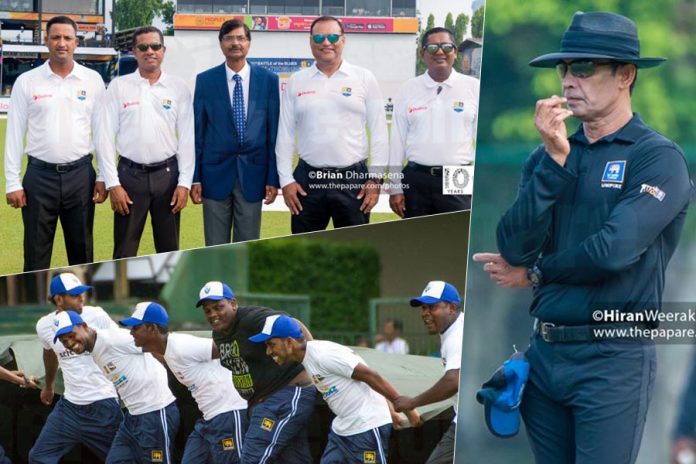We are all very well-versed on the escapades of the men performing between the ropes, but have you looked beyond it? We thought we will dig-in to some stories of a few lives that are entwined with this sport we love and how this pandemic has affected them.
Cricket is a sport which is loved across countries, cultures and religions. We follow how the cricketers on and off the field, we take their advice even on our commercial choices. They are treated as gods in some countries. But, is that what cricket is all about?
“I still have time to achieve my goals” – Angelo Mathews on his fitness journey
Apart from the 22 players battling in the centre, there are characters who are an integral part of the sport, but who may not enjoy the same spotlight. The scorers, umpires, match referees, groundsmen, and the media, without whom the sport would go nowhere.
Who are these scorers?
They are the ones who record what’s happening at the centre; facts and figures documented in excruciating detail. They are the reason why we know what happened on the 17th of March 1996 at Lahore. Every single ball! Their simple task is to follow the game, ball by ball, comply with the umpire, make sure that the scoreboard is accurate, record the game comprehensively and relay it to the stakeholders and record books.
The pint-sized dynamite – The legacy of Aravinda De Silva
With the evolution of the sport, scoring has grown as a profession around the world. In Sri Lanka, the regulating body for scorers is the Sri Lanka Cricket Scorers Association (SLCSA). There are about 250 members in the association among whom 120 are full members of the association who do cricket scoring as a full-time job.
There is a cricket match happening virtually every single day in Sri Lanka. These scorers are some of the busiest people in the cricket scene as the association assigns scorers to games ranging from premier level to the Division 3 schools category in all age groups. Apart from that, a friendlies or any game of cricket would be facilitated with a professional scorer upon request by the association.
For international games, the Sri Lanka Cricket assigns scorers through the umpire’s manager at the SLC. There are 4 scorers officially assigned for every international fixture. Two of them will be at the scoreboard, whose score sheets will be taken for official records, one will be in the media box as the ‘media scorer’ and another dedicated to handling the Duckworth–Lewis–Stern rate of the game in limited-overs cricket and one will be responsible for the giant screen in Test matches.
The minimum wage of a scorer in Sri Lanka is Rs 3500/- per day. But the pay increases depending on the tournament and cricketing levels. At international matches they earn Rs 9000/- a day, plus allowances. On average a full-time scorer will be in business for about 20 days a month.
Sri Lankan cricket followers know what the month of March means to the cricketing fraternity in the Isle. This is the period where the greatest number of matches are played in Sri Lanka. The schools’ big matches, Premier cricket season, Schools tournament and Mercantile cricket. For the scorers, its bonus time. “But with this COVID-19 pandemic falling right across March and April a full-time scorer is suffering at least a loss of Rs100000/-” said the assigning secretary of the SLCSA, Mr Chinthaka Munasinghe.
“Umpires are the main controllers of the game” – Sena Nandiweera (Former umpire)
This character plays a pivotal role in cricket. A panel of 4 umpires makes up an international match. For any other cricket game, you will need at least two umpires. It’s not as easy as it seems to be an international umpire. The umpires face a VIVA examination and an umpiring examination annually or every two years. Every two years they have a fitness test and a medical test every year. It’s not a must to have played the sport to be an umpire and you can start if you are over 25 years of age and could carry on until you are fit enough.
In Sri Lanka, the governing body for the umpires is the Association of Cricket Umpires in Sri Lanka (ACUSL). Some umpires are centrally contracted by the SLC. They are evaluated on a performance basis which depends on the captains’ reports and examinations. There are 3 gradings in ACUSL and 5 gradings in the SLC for umpires. To become a grade one umpire, you need to have 10 years of experience.
There are about 1000 qualified umpires in Sri Lanka and about 500 of them are constantly at work throughout the year. Among them, about 150 umpires do it for a living. On average a full-time umpire works about 150 to 180 days a year while a part-timer can go up till 50 to 100 days. The wages differ from Rs 3250/ to Rs 13000/- per day.
5 Short Tales about Tailenders
Again, this pandemic has washed-out the main source of income for some of these umpires. The ACUSL and the SLC have come forward and lent a hand to keep them afloat but it is not a flowery tale at the moment.
Match referees – keepers of the game
A steadfast but silent character in the scene is the match referee. A man responsible for upholding the spirit of the game and the conduct of players and other members involved in a cricket match. There are 7 Elite panel match referees in world cricket and about 35 match referees in Sri Lanka. Match referees were first introduced in Sri Lanka in 2003 and then on the sector has evolved to be part of SLC part-timers carder. Match referees are assigned by the SLC and are treated on an assignment basis. These are mostly former first-class and international cricketers. These men usually don’t do this as a profession, but purely for the love for the game. Yet, it is a well-paid assignment where a match referee earns Rs 11500/- plus allowances a day.
The pandemic situation may not have affected the match referees as gravely, other than create a sizable dent in their income.
Groundsmen – unsung heroes
Next in line are the ones who set the stage for these international stars to perform. From doctoring the pitch to managing the outfield, everything comes under the job role of the groundsmen or in some rare cases, women. If it had been like the olden days these men would have been the most affected by this situation. Luckily at present almost all the groundsmen are permanent staff in either the respective clubs or the SLC. Their general income would be around Rs 40000/- a month on average. But, due to this lockdown, only their basic salary will be paid which is about Rs 25000/- rupees which is a considerable loss for these workers.
Media – the ones who take the sport and the players to the people.
“In a pandemic like this each one has a role to play and for cricket media it is to keep people engaged and hold the interest for the sport until such time the live game come into play.” – Ganeesha David (Chief Editor – ThePapare.com)
This is a business which runs on content and to have content games must be played. Without the content, there won’t be any sponsors. With no cricket being played there won’t be any live coverage for advertisements. No current affairs for news. So it’s a tough time for the cricket journalists and sports media companies to keep their trade going. The losses could range from a few hundred thousand to billions.
But, the beauty of this sport is that it carries centuries-old stories and a spirit which everyone who knows the game could connect to. We at ThePapare.com will thrive to our best to bring out such stories and evoke that spirit to keep the love for this game going.
This shout out is to others to share with us their cricket stories in any language or form.
Send to – [email protected]

















